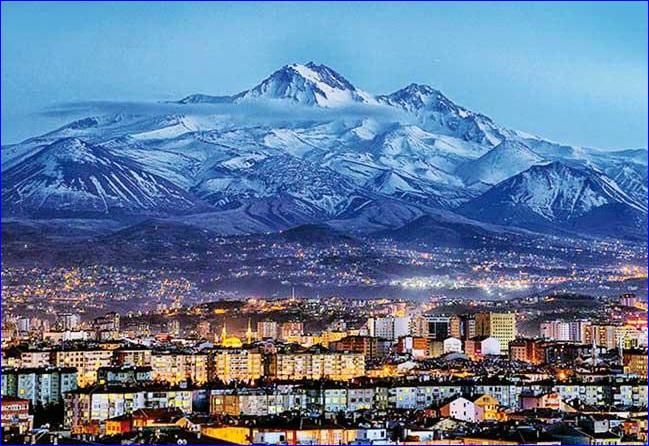


Kayseri has been continuously inhabited since circa 3000 BC. The ancient Kültepe near Kayseri is one of the first cities in Anatolia, being an important settlement on a critical location on the route of Assyrian trade colonies. By 2000 BC, the Assyrians had established commercial posts called karum, meaning simply "port," and in between these posts, there were small settlements called wabartum, meaning "guest" in Assyrian. One of the most important karums was the Kaneš in Kültepe, situated at the heart of the strong Hattian principality. The cuneiform clay tablets found in Kültepe reveal a great deal about the history of trade in Anatolia. Kayseri is known for its people having a gift in trade, jokingly sometimes attributed to their ancestry in Kaneš -- Kültepe.
The Roman period in Kayseri was known as Caesarea of Cappadocia, named in honor of Caesar Augustus. The city was called Kaisariyah by the Arabs, and later Kayseri by Seljuk Turks. The Seljuk period in Kayseri once again emerged as a critical trade point. Once the Seljuk rule was consolidated in Anatolia, their new and strong reign of stability and development sparked off commerce and trade, reviving the fading old trade routes. The main trade routes, or in a way highways of the period were laid on two main axes, one East-West, the other North-South; the latter providing access to the Black Sea via the ports of Sinop and Trabzon, and to the Mediterranean with the Alanya and Antalya harbors. At the intersection zone, the cities of Konya, Aksaray and Kayseri played a crucial role providing a bustling market for traders, Muslim, Jewish and Christian alike.
The medieval "Grand Road," named as "Ulu Yol" by the Seljuks, was connected to the Alanya harbor passing via Larende (today's Karaman) establishing the crucial Mediterranean port connection. The route used to split in Kayseri heading north to Sivas and to the port of Sinop in the Black Sea region, the other taking a twist to the south leading to the Far East through Malatya, Diyarbakır, and Mesopotamia or to Van and Iran. Interestingly, today's highways follow the same routes; today's Konya-Aksaray-Kayseri highway is exactly the same route of the Seljukid Ulu Yol.
On this route, huge seasonal temporary markets were also set up on the countryside for the merchandise of animals and the wholesale of agricultural produce. Yabanlu Pazarı, at Pazarören close to Kayseri, was probably the most prominent seasonal market of Seljuk Anatolia. It was a huge international fair set every May-June for 40 days attracting many visitors from faraway lands. Merchants and customers used to live temporarily in the area, setting up tents, some staying for the whole duration of the market. The tents would create almost a movable market town, lively and buzzing with foreign buyers. The location of the market was again at the place of an ancient Assyrian karum, apparently following the ancient trade route habits.
The Ottoman-period Kayseri continued to be known for its markets. Famous Ottoman traveler Evliya Çelebi who visited Kayseri in 1649 vividly describes the city as a hub of merchants, rich with abundant food sources; the granaries in the citadel were full of millet, wheat, rice, and hard biscuits. He counts several hans, devoted to the commerce of single items, like Pamuk Hanı for cotton trade, Un Kapanı, the flour han, Gön Hanı for leather, and so on. The long market he mentions was later covered with vaults and transformed to one of the biggest covered bazaars of Anatolia. Evliya says the people of Kayseri are strong and live long, perhaps due to the high altitude, cold weather and good and abundant food. He mentions butchers slaughtering hundreds of Karaman sheep and lambs, and putting rose petals and saffron on each meat sold. He also emphasizes the wheaten products, praises the white bread made from high quality white flour and the pastry cooks making flaky börek with clotted cream, and çörek with black pepper, cumin, almonds and sesame seeds. He also reports lahm-ı kadid, or in other words pastırma-pastrami, the cured beef coated with cumin and spices. He mentions there are 77 kinds of grains, cereals, vegetables and herbs sold in the markets of Kayseri; though he is known for his exaggeration at times, seemingly the Ottoman Kayseri was rich in its food choices.
Today's Kayseri cuisine exactly reflects that rich heritage, still strong in its wheaten dishes, savory pies and dumplings, and best cured meats and sucuk, spicy sausages.
Kayseri is a city of merchants, and a dip in its cuisine is like taking a journey to the past, a culinary voyage through the history of Anatolia with reflections of all civilizations that have lived and passed from this land of trade and commerce.
Fork of the Week:
When in Kayseri, the difficult question to avoid is: Which pastırma? The answer could be the ones made by grandmothers, but of course visitors have to rely on the market choices. A woman entrepreneur, Hülya Tiritoğlu, the daughter of famous pastırma producer Ömer Başyazıcı, has started her own line Çemen's, stocking a selection of pastırma and sucuk, but also worth checking for a variety of other local foods, frozen mantı, dolma, which is stuffed vine leaves, good sheep's milk yogurt and many other local delicacies including the bizarre tasting health drink gilaburu, the juice of Viburnum opulus, on www.cemens.com.tr or www.pastirmamarket.com
Cork of the Week:
The one and only wine producer in Kayseri is a women native of the town. Oluş Molu is the creator of Vinolus Wines and her wines are award-winning. Vinolus Chardonnay 2009 has received the silver medal twice in the Chardonnay du Monde competition, and Vinolus Syrah 2009 won silver in Concours Mondial de Bruxelles. Also check her Kalecik Karası, an Ankara grape that has perfectly adapted to Kayseri terroir in the Molu vineyards.

or register to post a comment.